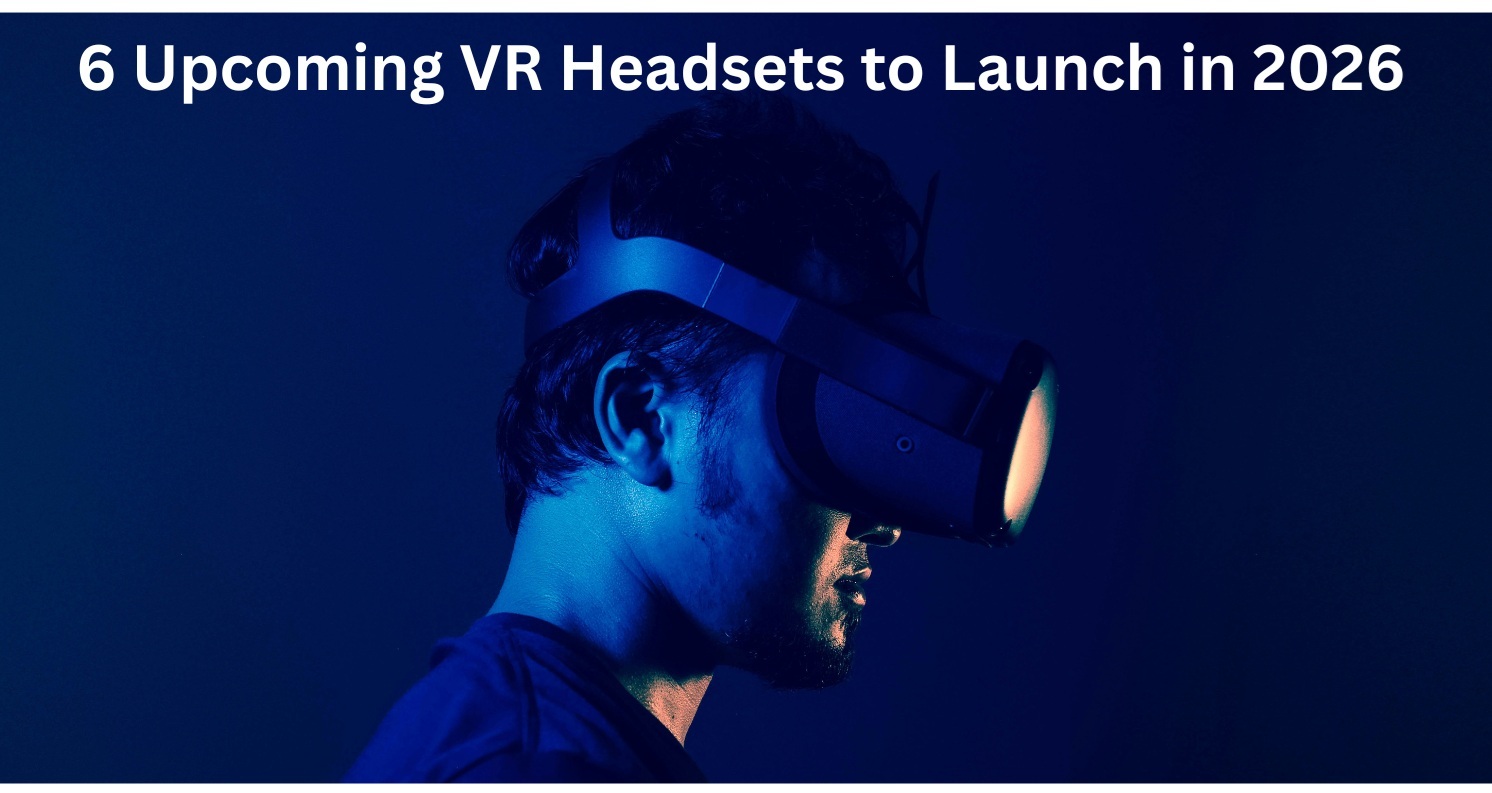Virtual Reality (VR) technology is advancing faster than ever, and by 2026, we’ll be seeing even more advancements with newer models from top names like Meta, Asus, Pimax, and even Apple. These upcoming, next-generation headsets won’t only be gaming-focused, but also productivity-focused. Apparently, we expect them to deliver higher-fidelity visuals, more intuitive dial controls, broader platform support, and be lightweight.
Here, we are looking at the top 6 VR/MR headsets mentioned to launch by 2026; the leaked features are just too inviting to ignore.
The 6 Upcoming VR Headsets to Launch in 2026
1. Valve Deckard (Steam Frame)
- Possible hybrid headset (standalone + PC VR via cable or wireless dongle)
- Up to 1440+ PPE, 120Hz
- Open audio design (like Steam Deck/Index) and spatial sound
- Expected to launch early 2026 with a price rumored to be around $1,200 for headset and controllers.
Also codenamed Steam Frame, the Valve Deckard is rumored to launch in 2026; it will be the company’s upgrade from the staple Valve Index VR. This upcoming headset is positioned in the high-end category and is expected to be a hybrid device, which means it’d function as a standalone headset and also a PC VR, running Valve’s own SteamOS.
Leaks suggest it will have top-tier specs such as 1440p per eye at 120Hz on micro-OLED (or high-density LCD) panels, pancake/aspheric lenses, eye-tracking with dynamic foveated rendering, inside-out camera tracking (no external sensors), and pair with new “Roy” ringless controllers with analog sticks, D-pad, and shoulder buttons.
This is expected to offer mixed-reality passthrough and leapfrog Meta’s Quest 3 in fidelity (higher resolution, eye-tracking), matching Apple’s AR vision (passthrough MR) at a fraction of the Vision Pro’s cost.
2. Meta Puffin (Loma)
- Ultra-light, glasses-style design
- Full color mixed Reality passthrough
- Meta’s Horizon OS with access to Quest content
- Expected to launch in 2026 with a price rumored to be under $1,000.
Here’s another potential bad boy, expected to build on the credibility of the Quest 2 and Quest 3 headsets. Codenamed Puffin, project “Loma,” this Meta’s next-rated VR device is rumored to be an ultralight design device that would appear more like VR glasses. Instead of a bulky visor, it is expected to tether via a cable to a small “puck” compute unit (similar to Meta’s Rift S concept).
Leaks say Puffin will weigh around 110 grams (just the glasses) and cost under $1000. It’s slated to ship in 2026. Like the Quest Pro, Puffin will include eye-tracking (for gaze-and-pinch input). Meta is reportedly in talks with Hollywood studios (Disney, A24, etc.) to produce immersive video content for this new gear, suggesting a focus on media as much as games.
Of course, this is expected to integrate a higher-end processor, more powerful than the Quest 3 series, and feature higher-resolution pancake lens optics. This device isn’t expected to run with traditional controllers; input will be via hand gestures and gaze.
3. Asus ROG Tarius
- Possible high-end micro-OLED or QD-LCD displays with local dimming
- Meta’s Horizon OS with access to Quest content
- Eye-tracking and face-tracking
- Possible rugged gaming aesthetics like ROGs
- Expected to launch in 2026, no price speculations yet.
Asus isn’t left behind in this VR chase; the brand is working on a high-end VR headset – in collaboration with Meta – under its Republic of Gamers (ROG) brand, codenamed Tarius. This is poised to be one of the first third-party headsets running Meta’s Horizon OS. Rumored features include eye-tracking and face-tracking, plus either high-contrast micro-OLED or QD-LCD displays with local dimming.
Yeah, this is going to be a performance gaming headset, think of it as the Meta Quest 3, but on steroids—sounds funny, right? Yeah! The headset will most likely employ the Snapdragon XR chipset (perhaps XR2 Gen3 or X2) to drive those displays. As of now, there’s no official launch date given, but rumors suggest Asus may tease it by Meta Connect 2025 and ship it in 2026 at the earliest.
4. Pimax Dream Air
- 8K displays: 3840×3552 per eye on Micro-OLED
- ConcaveView lenses; ultra-wide FOV, 110° horizontal, ~120° diagonal
- Eye tracking, auto IPD, and self-tightening strap
- Shipping from December 2025 (for the Lighthouse-tracking version)
Pimax’s Dream Air is a flagship PC VR headset with what we’d call “extreme specs.” Yeah, it’s official already—just haven’t started shipping yet. The headset features 3840×3552 pixels per eye on Sony micro-OLED screens, yielding over 27 million total pixels, which is significantly higher than any consumer headset in the market right now.
With Pimax’s new ConcaveView pancake lenses, this headset is able to achieve a 110° horizontal (≈120° diagonal) FOV, which, again, is the widest of any compact headset of the moment. Dream Air is a tethered headset (PC-only) with built-in eye tracking and integrated audio. It also has an innovative motorized self-tightening head strap and auto-adjusting IPD, good stuff!
There are actually two variants of this headset: the SteamVR (Lighthouse) version (sold at $2000) and the inside-out SLAM version with controllers ($2300).
5. Apple Vision Pro 2 (and Vision Air)
- Likely to feature similar micro-OLED panels as first-gen
- Inside-out tracking with hand gestures, eye-tracking, and spatial audio
- Apple Silicon M5 chip with VisionOS
- Expected to launch mid-to-late 2026 with a starting price around $3500
Oh yeah, Apple is coming up with a new one, the Vision Pro 2. We already know it’s going to bag a hefty price tag, but far from the cost, this new model is rumored to use Apple’s next-gen M5 chip for faster performance and better battery life, and ship with visionOS 26, which adds advanced AI spatial features and compatibility with PSVR2 controllers. Now, that’s interesting.
Apple is also said to redesign the head strap for comfort (addressing the weight issues of the existing model. Unrelated, but Apple is reportedly planning a more affordable “Vision Air” headset in like 2027; it’s going to be an ultra-light model, >40% lighter than Vision Pro and about 50% cheaper (roughly $1,500). In effect, Apple will have a two-tier strategy (like iPhone/SE).
6. Meta Quest 4 (Pismo Low/High)
- To run on Meta Horizon OS
- Possible two variants at launch: Pismo Low (value) and Pismo High (premium)
- 6DoF inside-out tracking with wireless controllers (Touch).
- Likely 120Hz display refresh with passthrough cameras
- Expected to launch in 2027, no price speculations at the moment.
Yes, Meta is working on a Quest 4 headset, although expected to launch in 2027; it’d be the company’s next standard VR headset. Earlier reports, as of last year, 2024, showed the company planned two models for 2026: a budget Pismo Low and a premium Pismo High, before it was later pushed back; however, the twin-variant strategy remains likely.
Both headsets will run on Horizon OS and support the Quest library. The high-end Pismo may include new features like eye-tracking (and possibly face tracking), rejuvenating Quest Pro capabilities, while the low-end keeps the core features at a lower price. Details on resolution and chipset are sparse, but improvements in display (higher resolution or OLED) and refresh rate (120Hz) are expected.
Conclusion
These are six VR/MR headsets expected to launch in 2026 and 2027. They are not too different from what’s existing right now (except for the Meta Puffin), just improved specifications and the addition of improved features. Stay with us as we keep blogging updates on these headsets and their launches.

